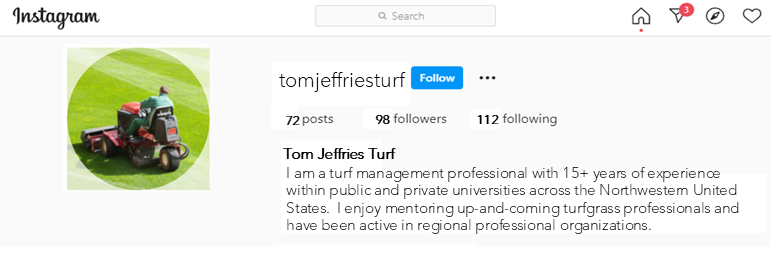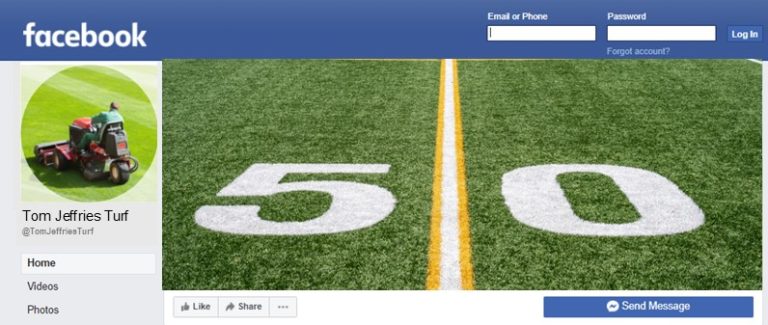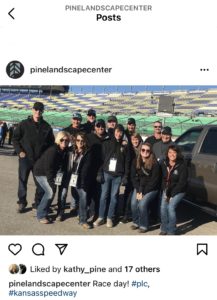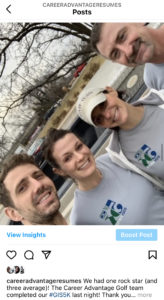By Erin Wolfram and Melissa Johnson
In our previous article on Professional Branding, we discussed the importance of creating a LinkedIn profile to help you elevate your online presence and build your personal brand. Now, we will focus on how you can effectively utilize other social media platforms and online portfolios to promote yourself professionally, as well as how they can contribute to attracting and retaining clients, customers, or visitors for your organization.
Elevate your brand through social media
Many of you may already have personal social media accounts for use with friends, family, and social acquaintances. Utilizing social media is also a great way to build your professional brand and market yourself to potential employers, especially if done well. Within the sports field management industry, using social media for professional purposes can be particularly effective because your achievements often can be proven through photos that tell a compelling visual story. If you decide you would like to start using social media platforms such as Facebook, Twitter and/or Instagram for professional use, it is strongly recommended that you have separate personal and professional accounts, since the purpose of each is likely very different. You will want to keep professional accounts public so potential employers can find you and learn more about your professional achievements. It is important to post regularly and share information that shows off your work, demonstrates a commitment to your industry, and proves the value you bring to an organization.
Similarly, online platforms can help you promote your organization’s services, keep visitors informed of facility and staff updates or events, engage with current and potential customers or visitors, provide an inside look at daily operations, and highlight key accomplishments of the entire team. If you are considering an organizational social media account, check with leadership to make sure they are on board with the idea, and find out if there are specific rules you need to follow to align with company standards, policies or procedures. It is possible that your facility already has a social media presence, so you may be encouraged to utilize established platforms to share maintenance department updates and information. The following are specific steps you can take to elevate your personal and/or organization’s brand through social media.
Choose your platforms wisely
When deciding which social media platform(s) to use, consider your audience, goals and content. If your anticipated followers are younger, Instagram may be your best option, while older audiences may respond better to Facebook. If you are establishing a social media presence for your organization and have the option, you may want to poll current customers or visitors to determine their preference. In addition to your target audience, it is also important to consider your social media goals and the type of content you would like to share when determining which platform to use. For example, if you are mainly interested in posting visual media, Instagram is a great choice. On the other hand, if you are planning to post more text-heavy, informative posts, or would like to promote events sponsored by your organization, then Facebook might be the better option. For simplicity, it may be best to choose one platform and execute it very well. The more social media accounts you have, the longer it will take and the harder they will be to maintain. Don’t forget to delete accounts you (or your organization) are no longer using!
Establish a consistent brand
If you choose to use more than one social media platform, make sure you are consistent across all accounts. Use the same profile and header photos, account name, account handle and/or latter part of each URL, and color scheme throughout each.



Share your new account(s)
Once you have created accounts, you need to attract followers. For personal accounts, you can do this by notifying your network via email; or, if you use LinkedIn, send private messages or share the information in a LinkedIn post. Similar to LinkedIn, Facebook also has industry-specific groups you can join, which can help you expand your network. Organizations can include social media account information in electronic or print newsletters, post signs around the property, and add URLs and handles to business cards.
TIP: Include your URLs and handles on your resume and online portfolio (more on that later). Professional social media accounts, whether personal or associated with your facility, can help potential employers access an inside view of your achievements.
Post content regularly
Remember, the type of content you post should reflect your personal or organizational brand, so be strategic in what you share, and keep it positive. Photos and videos typically receive the most engagement, so try to include media with each post, along with an appropriate caption explaining the photo or media. Get in the habit of taking pictures at work to capture moments you can share on social media. Also, do not be afraid to show your fun side.While professional social media accounts should focus on professional information, fun photos of crew team building activities or the mysterious cat that keeps showing up during a baseball game can add a nice, personalized touch. Finally, try to post at least once per week to keep your audience interested and engaged.
TIP: Always carefully proofread your content before posting. You do not want a typo or error to distract from the purpose of your post!
Content Ideas:
- High-quality facility photos
- Event announcements
- Photos of staff outings or appreciation events
- Four-legged crew members; everybody loves turf dogs!
- Fun facts about the facility or industry
- Customer/visitor appreciation posts
- Informative announcements, such as rain delays or closures
- Player spotlights
- Throwback photos
- Ticket purchasing information
- Project updates and progress photos
- Staff profiles
Engage with your audience
Regularly check your social media accounts to see if followers have commented or sent you a private message. It is best practice to reply or respond within 24 hours.Be prepared to deal with negative interactions. Sadly, no matter how hard you try, negative people exist and may comment on a post. If the comment is rational and you can understand the person’s perspective, having a professional dialogue addressing the comment is likely appropriate. However, if the comment is especially hateful and not founded on accurate information, it may be best to remove the comment. If necessary, block the person from accessing the account in the future.
Demonstrate your expertise through a professional website or online portfolio
In addition to establishing a professional social media presence, it may be beneficial to create a website and/or online portfolio you can use to further demonstrate your commitment to your industry and show your achievements. Initially, this may seem challenging and expensive; however, you can use free tools such as Wix.com or WordPress, which are content management website building systems that allow you to create an aesthetically pleasing website with little to no technical skills. A web portfolio is beneficial because it can be updated regularly as you acquire new expertise and accomplishments, and you can also add the URL to your resume. Creating a supplemental portfolio in document form saved as a PDF is also recommended, as you can print copies for the hiring committee to share and reference during an interview. Aim for the PDF version to be no longer than 12 pages.
Content ideas:
- Homepage with your name, contact information, a nice landscape photo of your facility, field, etc., a brief introduction of yourself, as well as links to your professional social media accounts. Include a menu at the top to help the reader navigate your site more easily.
- An “About” section on your homepage or a separate page that provides information on your background in the turf management industry as well as your future career aspirations.
- An abbreviated version of your resume with an option to download the full document. Including the full resume and possibly a cover letter is recommended for PDF versions.
TIP: Remove your address on the web version if it is on your resume.
- Content that highlights your philosophy on such topics as turf management, agronomy, crew management, budget creation, future planning, etc.
- Four to five select projects featuring accomplishments that demonstrate your skills. For each project, include two to four photos with captions, as well as text explaining the project, its purpose, the role you played in completing it, and the outcomes.
- Recommendation letters from current and past supervisors, crew members, and colleagues.
- A gallery of photos showing the history of your work, as well as photos of your crew.
- Other artifacts or information you feel are relevant and demonstrate your qualifications, including awards, publications, certifications and leadership roles.
Social media and portfolios are valuable tools for establishing a professional image for you and your organization. Think about what platforms and tools might work best for you and your unique situation, and start building your personal brand today!
Erin Wolfram has more than 15 years of experience in career services, and owns and operates Career Advantage Golf (http://careeradvantagegolf.com), specializing in career services for those in the turf management field. She has a podcast called A Year of Career: 52 Practical Answers to Your Questions, where she provides quick career and job search advice. Wolfram has a Bachelor of Science in Secondary English Education, Master of Science in Counseling Psychology, Master of Science in Educational Technology, and is a certified professional etiquette consultant. She can be reached at erin@careeradvantageresumes.com.
Melissa Johnson has more than 20 years of experience working with individuals from a variety of careers and industries. She specializes in one-on-one career coaching, resume and cover letter development, and job search assistance. Johnson has a passion for providing individualized support and guidance for each of her clients to ensure they can achieve their career goals. She has a Bachelor of Arts in Psychology and a Master of Education in Counseling Psychology.





